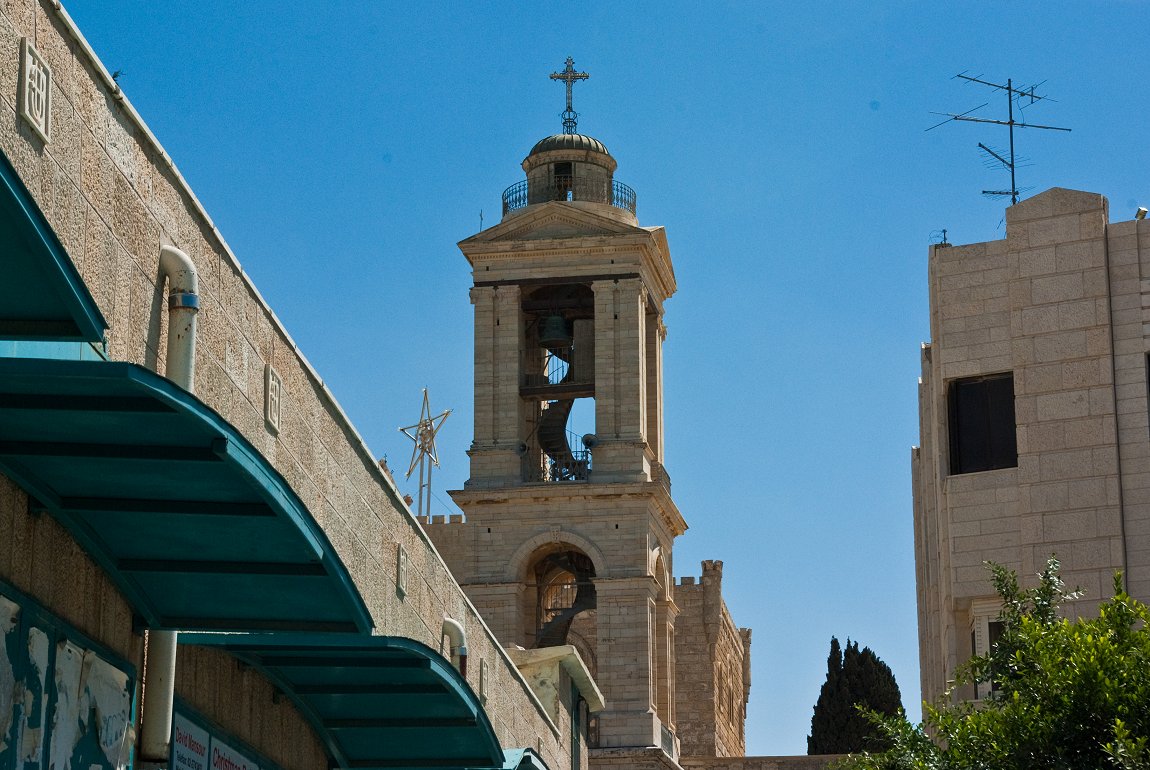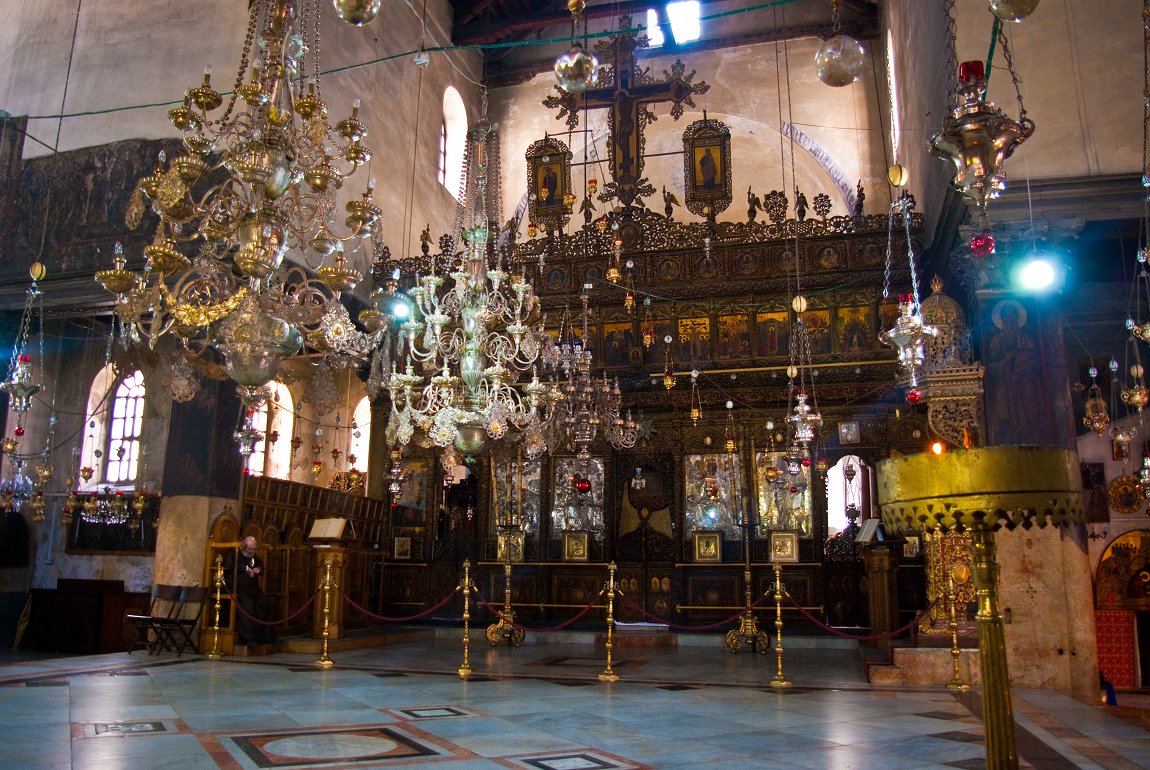"Joseph took up his quarters in a certain cave near the village; and while they were there Mary brought forth the Christ and placed Him in a manger, and here the Magi who came from Arabia found Him."(chapter LXXVIII).
Another source, early Christian scholar, theologian and one of the most distinguished early fathers of the Christian church, Origen Adamantius of Alexandria (ca. 185-ca. 254) wrote:

Bell tower of the Church of the Nativity, Bethlehem
Source: https://commons.wikimedia.org/wiki/File:Church_of_the_Nativity_%28Bethlehem%294.jpg
Author: Antoine Taveneaux

"In Bethlehem the cave is pointed out where He was born, and the manger in the cave where He was wrapped in swaddling clothes. And the rumor is in those places, and among foreigners of the Faith, that indeed Jesus was born in this cave who is worshipped and reverenced by the Christians." (Contra Celsum, book I, chapter LI).
Helena, the mother of Emperor Constantine I, built the first basilica on this site. It was built under the supervision of Bishop Makarios of Jerusalem, and was completed in 333 AD. It was destroyed in the Samaritan Revolt of 529 AD.
The current basilica was rebuilt in its present form in 565 AD by the Emperor Justinian I. When the Persians under Chosroes II invaded in 614, they unexpectedly did not destroy the structure. According to legend, their commander Shahrbaraz was moved by the mosaic depiction inside the church of the Three Magi wearing Persian clothing, and commanded that the building be spared. The Crusaders made further repairs and additions to the building during the Latin Kingdom of Jerusalem with permission and help given by the Byzantine Emperor. Over the years, the compound has been expanded, and today it covers approximately 12,000 square meters.
The church is administered jointly by Greek Orthodox, Roman Catholic, and Armenian Apostolic authorities. All three traditions maintain monastic communities on the site.

Interior of the Church of the Nativity, Bethlehem
Source: https://commons.wikimedia.org/wiki/File:Church_of_the_Nativity_%28Bethlehem%29.jpg
Author: Antoine Taveneaux

The Church of the Nativity comprises two churches with a crypt beneath - the Grotto of Nativity - where Jesus Christ is said to have been born.
The main Basilica of the Nativity is run by the Greek Orthodox Patriarchate of Jerusalem. The basilica is designed like a typical Roman basilica. It has five aisles formed by Corinthian columns and an apse in the eastern end, where the sanctuary is. The church features golden mosaics covering the side walls, which are now largely decayed. The basilica is entered through a very low door, called the "Door of Humility." The original Roman style floor has since been covered over. Nonetheless, a trap door in the modern floor allows for a portion of the original mosaic floor to be seen. The church also features a large gilded iconostasis, and a complex array of lamps throughout the entire building. The wooden rafters were donated by England's King Edward IV, who also donated lead to cover the roof. This lead was later taken by the Turks, who melted it down for ammunition to use in war against Venice. Stairways on either side of the Sanctuary lead down by winding stairs to the Grotto of Nativity.
The Church of St. Catherine, the Roman Catholic church, adjoins the Basilica of the Nativity. It was built in a more modern Gothic revival style, and has been further modernized according to the liturgical trends which followed the Second Ecumenical Council of the Vatican (Vatican II). This is the church where the Latin Patriarch of Jerusalem celebrates Midnight Mass on Christmas Eve. Certain customs still observed in this Midnight Mass predate Vatican II, but must be maintained because the "status quo" (the customs, rights and duties of the various church authorities that have custody of the Holy Places) was legally fixed by a firman in 1852, under the Ottoman Empire, that is still in force to this day.
The Grotto of the Nativity is an underground cave beneath the basilica. It enshrines the spot where Jesus is said to have been born. A 14-pointed silver star marks the exact spot set into the marble floor and surrounded by silver lamps. This altar is denominationally neutral, although it features primarily Armenian Apostolic influences. Another altar in the Grotto, which is maintained by the Roman Catholics, marks the site where traditionally Mary laid the newborn babe in the manger.
Numerous Chapels are found in the compound including the Chapel of Saint Joseph, commemorating the angel's appearance to Joseph, commanding him to flee to Egypt, as mentioned in Matthew 2:13, the Chapel of the Innocents, commemorating the children killed by Herod the Great, as mentioned in Matthew 2:16-18, and the Chapel of Saint Jerome, where traditionally he translated the Bible into Latin (the Vulgate).
Manger Square, a large paved courtyard in front of the Church, is the site where large crowds will gather on Christmas Eve to sing Christmas carols in anticipation of the midnight services.
Siege at the Church of the Nativity
Violence broke out at the Church of the Nativity between March and May of 2002. From March to April, the Israeli Defence Forces carried out "Operation Defensive Shield" in the West Bank. Bethlehem was in the line of fire in the effort to root out militants. On 1 April, 2002, Israeli tanks surrounded Bethlehem. Israeli military planes, tanks and troops entered the city, sparking worldwide criticism, due to the sensitive nature of the Bethlehem.200 Palentinians - including militants - fled the Israeli forces and took refuge in the Church of the Nativity. In the ensuing siege, nine Palestinians as well as the Chuch bell-ringer were killed. Many more were wounded. A monk was also killed by indirect fire. According to a Franciscan priest present inside the church "by choice" during the siege, "the gunmen kept their weapons with them at all times, and in the first days took candelabras, icons, candles and "anything that looked like gold." Some of the valuables were later returned.
The Israeli Army left only after the full evacuation of the Church of the Nativity on May 22. At least one monk had been trapped in the basilica with the Palestinians.
 Latest updates on Penang Travel Tips
Latest updates on Penang Travel Tips
 Discover with Timothy YouTube Channel
Discover with Timothy YouTube Channel
 PG Food Channel
PG Food Channel
 Learn Penang Hokkien YouTube Channel
Learn Penang Hokkien YouTube Channel
 SojiMart Videos
SojiMart Videos
 Share your travels and/or ask a travel-related question
Share your travels and/or ask a travel-related question
Join the Penang Travel Tips Facebook Group to share photos, tips and anything related to your travels, or ask travel-related questions.
 Map of Roads in Penang
Map of Roads in Penang
Looking for information on Penang? Use this Map of Roads in Penang to zoom in on information about Penang, brought to you road by road. Discover with Timothy
Discover with Timothy
Let me take you to explore and discover Penang through my series of walking tours on YouTube. You may use these videos as your virtual tour guide. At the beginning of each video, I provide the starting point coordinates which you may key into your GPS, Google Maps or Waze, to be navigated to where I start the walk, and use the video as your virtual tour guide.Disclaimer
Please use the information on this page as guidance only. The author endeavours to update the information on this page from time to time, but regrets any inaccuracies if there be any.Latest from Discover with Timothy: Gurney Bay - what to see and do there
About this website

Hello and thanks for reading this page. My name is Timothy and my hobby is in describing places so that I can share the information with the general public. My website has become the go to site for a lot of people including students, teachers, journalists, etc. whenever they seek information on places, particularly those in Malaysia and Singapore. I have been doing this since 5 January 2003, for over twenty years already. You can read about me at Discover Timothy. By now I have compiled information on thousands of places, mostly in Peninsular Malaysia and Singapore, and I continue to add more almost every day. My goal is to describe every street in every town in Malaysia and Singapore.
Robbie's Roadmap
- Episode 1: Robbie's Journey to Financial Freedom
- Episode 2: Lost in America
- Episode 3: The Value of Money
- Episode 4: The Mentor
- Episode 5: The Thing that Makes Money
- Episode 6: The walk with a Billionaire
- Episode 7: The Financial Freedom Awakening
- Episode 8: Meet Mr Washington
- Episode 9: The Pizzeria Incident
Copyright © 2003-2024 Timothy Tye. All Rights Reserved.


 Go Back
Go Back